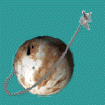
Current Issues:
SpaceViews
SpaceViews Update
Breaking News
Back Issues
Search
Subscriptions
Submissions
Forum
Space Sites of the Week
Home
The Science of Mars Pathfinder
Although the Mars Pathfinder spacecraft is rather small, is it packed with several scientific instruments that will provide key information about the Martian surface and atmosphere that will both provide a baseline to compare Mars with conditions 21 years ago, when the Viking spacecraft landed there, and learn new information about the planet.
The spacecraft has three main instruments. The Imager for Mars Pathfinder (IMP), a stereo camera mounted on a meter-high mast connected to the lander, is capable of observations in a wide range of wavelengths. The Atmospheric Structure Instrument/Meteorology Package (ASI/MET) will not only return information on the atmospheric composition and wind conditions at the surface, but return information as Pathfinder makes its descent to the surface. The Alpha Proton X-Ray Spectrometer (APXS) is attached to the Sojourner rover and will be able to sample the composition of rocks and soil around the landing site.
![[image of IMP]](images/imp.jpg) The science objectives of the mission fall under two broad categories: surface geology, including the composition and morphology (structure) of rocks and soil on the surface; and atmospheric studies, which include the composition and dynamics of the Martian atmosphere.
The science objectives of the mission fall under two broad categories: surface geology, including the composition and morphology (structure) of rocks and soil on the surface; and atmospheric studies, which include the composition and dynamics of the Martian atmosphere.
Surface geology will likely get the most attention from the mission, because of its use of Sojourner and heavy reliance on images. The IMP will take panoramic stereo images of the surface that geologists on Earth will analyze to understand the distribution and shape of the rocks visible. Other images of tracks made by Sojourner and any visible impressions caused by bounces during the landing procedure will help researchers learn more about the firmness of the surface and any features visible immediately under the surface.
Images will also be used to learn more about the magnetic properties of the Martian soil. Magnets of various strengths have been placed on the lander, which are expected to attract dust throughout the mission. Images of these dust samples will be taken at different wavelengths, which should help researchers determine what materials make up the dust.
![[image of APXS on Sojourner]](images/spectrometer.jpg) More precise information on the composition of rocks and soil will come from the APXS on Sojourner. The spectrometer uses a small alpha particle (a particle which consists of two protons and two neutrons, identical to helium nuclei) source to illuminate a sample of rock or soil. The spectrometer then records the x-rays, protons, and alpha particles scattered back. Researchers will compare this data with results from known materials to learn the composition of the rocks and soil. Images from the lander will also help in the identification of specific minerals and elements.
More precise information on the composition of rocks and soil will come from the APXS on Sojourner. The spectrometer uses a small alpha particle (a particle which consists of two protons and two neutrons, identical to helium nuclei) source to illuminate a sample of rock or soil. The spectrometer then records the x-rays, protons, and alpha particles scattered back. Researchers will compare this data with results from known materials to learn the composition of the rocks and soil. Images from the lander will also help in the identification of specific minerals and elements.
The ASI/MET instrument will start recording data on the temperature and density of the Martian atmosphere as Pathfinder descends towards the surface. Once on the surface it will deploy sensors on a meter-high mast to measure temperature and wind speed at several heights between the surface and the top of the mast, to understand the atmospheric profile at the very bottom of the atmosphere. Wind direction will be measured by several wind socks mounted on the mast; the orientation of the wind socks will be measured in images taken by the IMP.
Scientists will also get data on a global aspect of the planet from the spacecraft's radio system. By sending radio signals to and from the spacecraft, researchers will be able to measure the spacecraft's precise distance from Earth (to within a few meters), and use the Doppler shift in the signals caused by the movement of Mars to get other distance information.
This information will be used to find the exact location of Pathfinder on the Martian surface, from which researchers can find the orientation and precession rate of the poles of the planet, which is dependent on the "moment of inertia" of the planet, which is in turn controlled by the interior structure of Mars. This can lead to a better understanding of what the planet is like deep below its surface.
For more information on the instruments carried by Mars Pathfinder, visit http://mpfwww.jpl.nasa.gov/mpf/sci_desc.html, and for more details on the science they will conduct, check http://mpfwww.jpl.nasa.gov/mpf/science_obj.html.
